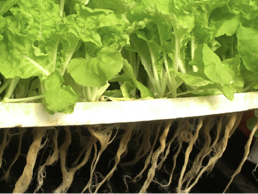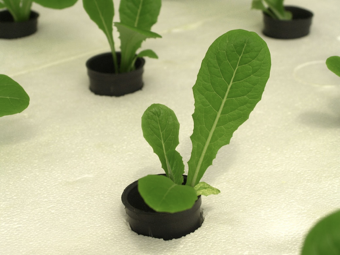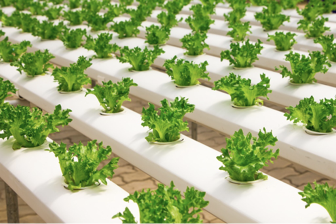Hydroponics for Beginners

Today’s guest post is by Hydroponics blogger Jonathan de Araujo. Read more of Jonathan’s articles at uPONICS.com.
In recent years, hydroponics has really taken the gardening world by storm. You may have heard about it in the news, bought hydroponic lettuce at the grocery story, or even spotted a new hydroponics store in your town. But what exactly is hydroponics? A lot of people have a vague understanding of the concept but don’t know its advantages or how this unique gardening technique works. To help you understand the basics, here is my brief overview into hydroponics for beginners.
An Overview of Hydroponics

Hydroponics is a method of gardening whereby plants are grown in water rather than in soil. The term “hydroponics” has its origins in the Greek words “hydro” (water) and “ponos” (work or labor). Thus, the literal definition is “water working.”
But plants require more than just water to survive. They also need nutrients for health, light for photosynthesis, and carbon dioxide and oxygen to breathe. So long as a plant receives adequate amounts of these things, they are in a good position to grow in a healthy manner, regardless of whether you use soil or hydroponics.
Since soil and the natural elements are not a factor in hydroponics, you are the one in total control of the growing condition. As such, you must provide the proper inputs to be successful. These include adding nutrient solution (water and fertilizer mix) to feed the plants, as well as providing the correct lighting and grow medium (the soil substitute).
Advantages of Hydroponics

If you give your plants what they need – when they need it – hydroponically-grown plants are able to produce higher yields, faster growth, and even better quality crops compared to those grown in soil.
Why is hydroponics so efficient? For one, plants are able to grow faster and larger because they don’t have to work as hard to find their nutrients. While the root systems of soil plants are forced to expand in an effort to seek out their nutrients, roots of hydroponic plants don’t need to expand as much because they are directly exposed to nutrients which you provide. These smaller root systems means that energy can be directed towards the foliage growth instead of into developing its root system. This efficiency can result in up to 50% fast growth compared to soil-grown plants.
Hydroponics can be conducted indoors, year round, and in small spaces. You are not subject to the whims of Mother Nature, and you can grow several crops in the same space throughout the year. This will give you at least a few plant-to-harvest cycles per year and increase your overall yield by a great deal. Additionally, you have few bugs and pests to contend with because you are not using soil. Hydroponics also eliminates a lot of waste because you are constantly reusing the water and nutrients in your hydroponic system.
Disadvantages of Hydroponics

While hydroponics has plenty of advantages, there are a few notable disadvantages as well. For one, the components that make up a hydroponic system can be more costly than those needed for conventional soil gardening. Your hydroponics system may require things such as grow media, fertilizer, pumps, air stones, timers, and grow lights. The good news in that your fertilizer may be the only component you need to purchase again. Thus, the cost of hydroponics is certainly front-end loaded.
Beside the cost, you will have to devote some time to monitoring your hydroponics system. You will have to change the water and nutrients every couple of weeks, and check the pH levels so they stay within the proper range. Also, many components of a hydroponic system setup are dependent on electricity (pumps, timers, and grow lights). If you have a power outage, your plants could be devastated. Additionally, while most plants and herbs are suitable for hydroponic gardening, crops like corn, potatoes, squash, and melons should be avoided. Herbs, greens, tomatoes, peppers, and other non-vining and above-ground crops work best.
What you need for Hydroponics
Here are some of the common components of hydroponics. Note that while more experienced growers typically purchase each component separately and piece the system together (ie, DIY), beginners may prefer to buy a hydroponics kit (with all the components bundled together into one package) or an ease-to-use AeroGarden system.
- Growing Medium: Grow media acts as a soil substitute in hydroponics. It gives the plant support by holding its roots and also provides moisture retention and aeration to the root zone. Any grow media you choose should be inert, pH neutral, and somewhat porous. Examples include clay pebbles, perlite, grow rocks, lava rocks, rockwool, and coco coir.
- Grow Trays: A grow tray is the grow bed where plants are held. Most hydroponic grow trays are filled with grow media and placed above the reservoir.
- Reservoirs: A hydroponic reservoir is the place where nutrient solution is stored. Often a pump and airstone will be kept inside the reservoir.
- Timer and Pump: Many hydroponic systems use pumps (submersible or non-submersible) to draw the nutrient solution from the reservoir to the grow trays. A timer can be used to control when the nutrient solution is pumped into the grow beds, and also to turn the grow lights off and on.
- Grow Lights: Indoor hydroponic plants need appropriate grow lights to stimulate the photosynthesis process. Normal light bulbs are not adequate for hydroponics. Most growers rely on specialty full-spectrum grow lights which mimic the sun’s natural spectrum of light. LED grow lights are probably the best option for beginners because they are effective, energy efficient, easy to operate, and aren’t prone to overheating issues.
- Hydroponic fertilizer: Conventional fertilizers are not appropriate for hydroponic plants. Instead, you should use a fertilizer that is specifically made for hydroponic systems. Organic fertilizers are problematic with hydroponics, unfortunately.
- pH Test Kit: To be successful. you need to balance the pH-level of your nutrient solution. There are pH-adjusting products on the market specifically designed for hydroponics.
6 Types of Hydroponic Systems

Different varieties of Hydroponic systems are the way in which hydroponic plants are grown. They can be active or passive and recovery or non-recovery. In active systems, a pump moves the nutrient solution through the system, whereas a passive system uses the grow media or a nylon wick to draw the nutrient solution up to the root zone. A recovery system recycles the nutrient solution within a hydroponics system while a non-recovery system disgards the nutrient solution after it is used once time.
There are six main types of systems in hydroponics: Aeroponics, Deep Water Culture, Drip, Ebb & Flow (Flood & Drain), Nutrient Film Technique, and Wick. The goal of each system is to deliver moisture, nutrients, and oxygen to the roots of a plant. Each system works a little differently, as you will see below:
Aeroponics: Roots are suspended in an air chamber (usually no grow media is used). The bare roots are misted periodically with a nutrient solution. Aeroponics uses a pump and timer to deliver the nutrient solution. Plants experience fast growth because the roots receive so much oxygen and nutrients are delivered directly to the roots. (Not for beginners)
Deep Water Culture (DWC): In DWC systems, the plant’s roots are placed in net pots (filled with grow media) and then submerged in nutrient-rich water. Air stones are placed inside the reservoir provide oxygen to the nutrient solution. Deep Water Culture is a good choice for beginners because it’s simple, low maintenance, and effective.
Drip System: The Drip System may be the most popular system in hydroponics. It works by constantly (but slowly) dripping nutrient solution onto the grow media and into the root zone. This supplies a steady stream of moisture and fertilizer to the plants at all times. Drip systems use drip rings and pumps but timers are not used.
Ebb and Flow: The Ebb and Flow (also known as Flood and Drain) works by flooding the growing beds with nutrient solution at specific times. Once the grow bed has been flooded, the nutrient solution then slowly drains back into the reservoir until the next flooding. Plants can experience rapid growth as a result of these periods of drying out between feedings. The timer and pump are crucial components to Ebb and Flow systems.
Nutrient Film Technique (NFT): NFT systems use slightly tilted gullies or channels (sometimes PVC pipes) as the grow beds, with holes cut out to hold the plants (usually in net cups with grow media). A thin stream of nutrient solution flows continuously through these gullies and over the tips of the bare roots of plants, then returns back to the reservoir. A pump keeps the nutrient solution continuously flowing throughout the system. NFT is popular with commercial herb and lettuce growers.
Wick System: The Wick System is the probably the most simplistic and lowest cost hydroponic system because there are so few parts. No pump, timer, or even electricity is used. Instead, a Wick System uses a fibrous rope (like nylon) to draw the nutrient solution up from the reservoir and into the grow bed (via capillary action). Grow media (like coco coir) helps to retain moisture and nutrients, and to support the plant (so it stays upright). Great for beginners and herb growers.
There is plenty more to learn about hydroponics, but I hope this article provided a helpful start.
For additional information on Hydroponic Gardening you might want to read more on the water involved: Water Chiller Hydroponics: A Definitive Guide (2019 Update)
Good luck with your garden this year!
